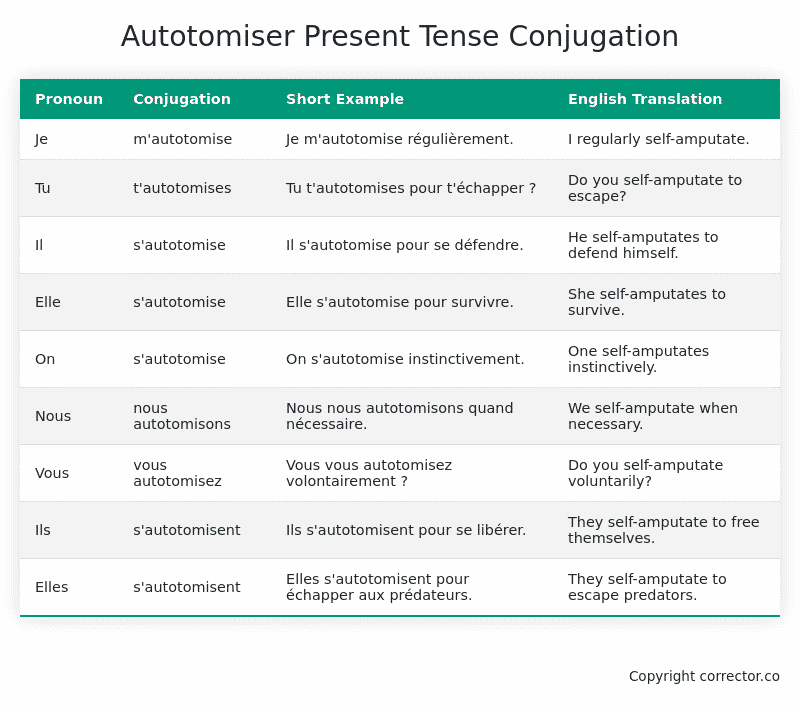Le Present (Present Tense) Conjugation of the French Verb autotomiser
Introduction to the verb autotomiser
The English translation of the French verb “autotomiser” is “to autotomize.” The infinitive form of “autotomiser” is pronounced as oh-toh-toh-mee-zay.
The language origin of “autotomiser” derives from the Greek words “auto” meaning “self” and “temnein” meaning “to cut.” In everyday French, “autotomiser” is used in a more scientific or biological context, referring to the ability of certain animals to voluntarily shed or detach a body part, such as a tail or limb, as a defense mechanism.
Examples:
- Les lézards peuvent autotomiser leur queue lorsque menacés. (Lizards can autotomize their tail when threatened.)
- Certains arthropodes sont capables de s’autotomiser une patte pour se libérer d’un prédateur. (Certain arthropods can autotomize a leg to escape from a predator.)
- Les étoiles de mer ont la capacité de s’autotomiser leurs bras afin de se régénérer. (Starfish have the ability to autotomize their arms in order to regenerate.)
Remember, this information is only about the verb “autotomiser” and its usage in French.
Autotomiser – About the French Present Tense
To take a deep dive into all the French tenses then see our article on Mastering French Tense Conjugation.
Common Everyday Usage Patterns For Le Present
Interactions with Other Tenses
Table of the Present Tense Conjugation of autotomiser
| Pronoun | Conjugation | Short Example | English Translation |
|---|---|---|---|
| Je | m’autotomise | Je m’autotomise régulièrement. | I regularly self-amputate. |
| Tu | t’autotomises | Tu t’autotomises pour t’échapper ? | Do you self-amputate to escape? |
| Il | s’autotomise | Il s’autotomise pour se défendre. | He self-amputates to defend himself. |
| Elle | s’autotomise | Elle s’autotomise pour survivre. | She self-amputates to survive. |
| On | s’autotomise | On s’autotomise instinctivement. | One self-amputates instinctively. |
| Nous | nous autotomisons | Nous nous autotomisons quand nécessaire. | We self-amputate when necessary. |
| Vous | vous autotomisez | Vous vous autotomisez volontairement ? | Do you self-amputate voluntarily? |
| Ils | s’autotomisent | Ils s’autotomisent pour se libérer. | They self-amputate to free themselves. |
| Elles | s’autotomisent | Elles s’autotomisent pour échapper aux prédateurs. | They self-amputate to escape predators. |
Other Conjugations for Autotomiser.
Le Present (Present Tense) Conjugation of the French Verb autotomiser (You’re reading it right now!)
Imparfait (Imperfect) Tense Conjugation of the French Verb autotomiser
Passé Simple (Simple Past) Tense Conjugation of the French Verb autotomiser
Passé Composé (Present Perfect) Tense Conjugation of the French Verb autotomiser
Futur Simple (Simple Future) Tense Conjugation of the French Verb autotomiser
Futur Proche (Near Future) Tense Conjugation of the French Verb autotomiser
Plus-que-parfait (Pluperfect) Tense Conjugation of the French Verb autotomiser
Passé Antérieur (Past Anterior) Tense Conjugation of the French Verb autotomiser
Futur Antérieur (Future Anterior) Tense Conjugation of the French Verb autotomiser
Subjonctif Présent (Subjunctive Present) Tense Conjugation of the French Verb autotomiser
Subjonctif Passé (Subjunctive Past) Tense Conjugation of the French Verb autotomiser
Subjonctif Imparfait (Subjunctive Imperfect) Tense Conjugation of the French Verb autotomiser
Conditionnel Présent (Conditional Present) Tense Conjugation of the French Verb autotomiser
Conditionnel Passé (Conditional Past) Tense Conjugation of the French Verb autotomiser
Conditionnel Passé II (Conditional Past II) Tense Conjugation of the French Verb autotomiser
L’impératif Présent (Imperative Present) Tense Conjugation of the French Verb autotomiser
L’impératif Passé (Imperative Past) Tense Conjugation of the French Verb autotomiser
L’infinitif Présent (Infinitive Present) Tense Conjugation of the French Verb autotomiser
L’infinitif Passé (Infinitive Past) Tense Conjugation of the French Verb autotomiser
Le Participe Présent (Present Participle) Tense Conjugation of the French Verb autotomiser
Le Participe Passé (Past Participle) Tense Conjugation of the French Verb autotomiser
Struggling with French verbs or the language in general? Why not use our free French Grammar Checker – no registration required!
Get a FREE Download Study Sheet of this Conjugation 🔥
Simply right click the image below, click “save image” and get your free reference for the autotomiser present tense conjugation!

I hope you enjoyed this article on the verb autotomiser. Still in a learning mood? Check out another TOTALLY random French verb present conjugation!


